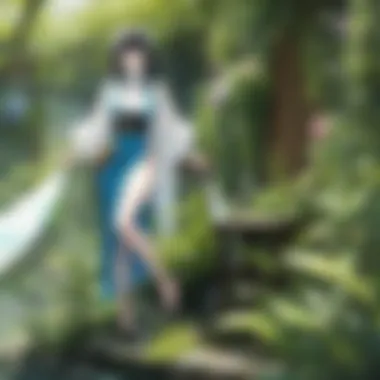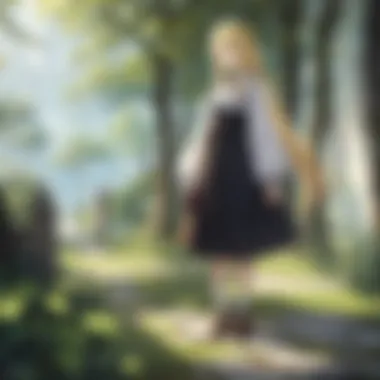The Symbolic Role of Vegetation in Manga and Anime


Intro
Vegetation in manga and anime holds a significant role, often extending beyond mere background scenery. Plants and natural scenes serve essential purposes within the narrative. They establish mood, communicate character feelings, and symbolize deeper themes. This article will analyze how these elements work intricately in various series, providing insights into their contribution to storytelling.
Series Overview
Synopsis and Premise
Manga and anime often showcase landscaped world-building that reflects the story's emotional tone. Series like Nausicaä of the Valley of the Wind delve into ecosystems filled with lush vegetation and complex relationships between humanity and nature. The story highlights nature's fragility, reflecting a deeper environmental theme that resonates with audiences.
Notable Characters
Characters often interact with plant life in profound ways. In My Neighbor Totoro, Satsuki and Mei's bond with the forest spirits is articulated through their connection with the flowers and trees around them. Such relationships show that vegetation is not only a backdrop but a pivotal element of character development and interaction.
Themes and Motifs
Major Themes Explored
Various themes surface through vegetation in these stories. Nature often embodies concepts of life, growth, decay, and rebirth. In Attack on Titan, the contrast between the natural world and industrialization plays a crucial role in the narrative, pushing characters to confront the consequences of their choices and actions.
Symbolism in Storytelling
Plants symbolize emotions and cultural aspects relevant to the narrative. Cherry blossoms, for example, convey beauty and transience, as seen in Your Name. The fascination with ephemeral beauty is tied to cultural appreciation for seasons and cycles in nature. This symbolism enriches a viewer’s experience, allowing for personal reflections on life and change.
Artistic Style and Animation
Visual Aesthetics and Design
The representation of vegetation significantly influences the artistic style in anime and manga. The intricate designs of flora contribute to the visual storytelling. In series like Land of the Lustrous, the light that interacts with crystalline plants creates a mesmerizing effect, enhancing the storytelling experience and immersing the audience in the world.
Animation Techniques and Trends
Early anime often depicted simple, flat backgrounds. However, modern productions utilize advanced techniques to create lifelike representations of plants. The dynamic presentation in series like Demon Slayer: Kimetsu no Yaiba showcases how skilled animation can breathe life into vegetation, making it a character in its own right.
"Vegetation is not just a backdrop; it shapes the very essence of narrative and character in literature and visual art."
Prelims to Vegetation in Media
Vegetation serves a crucial role across various media, especially in manga and anime. These narratives utilize the representation of plants and natural elements to enhance storytelling and deepen character development. This section explores the importance of vegetation in these artistic forms, discussing specific elements, benefits, and considerations.
Plants feature prominently, often symbolizing emotions, growth, and transformation. They are not just backdrops but integral to the themes and character arcs present in the stories. Mazing landscapes can reflect the internal struggles of a character, illustrating mood shifts or narrative tension. Through various examples, vegetation acts as a visual cue that enhances the viewer's connection to the story.
In addition, the cultural aspects of plants resonate significantly within Japanese society. The significance of flora in traditions and seasonal changes adds layers of meaning. Readers can appreciate the deeper connection characters have with the environment, which may vary across different series. Ultimately, understanding vegetation in anime and manga is about grasping how this relationship shapes narratives and viewer experiences.
Understanding the Concept of Vegetation in Anime and Manga
The concept of vegetation in anime and manga involves more than just aesthetic choices. It encompasses ecological dynamics, symbolism, and character interaction with the environment. Vegetation is depicted in different forms, from sprawling forests to delicate blossoms. These depictions evoke feelings and can represent various themes like hope, despair, or renewal. The use of plants is often deliberate, meshing with the storyline to mirror character journeys. For instance, a wilting flower might parallel a character's decline, whereas vibrant greenery may symbolize growth and hope.
Moreover, plants can serve as narrative devices, offering insight into world-building. The portrayal of flora provides context about the setting. For example, cherry blossoms in Japanese anime often signify fleeting beauty and the ephemeral nature of life. When utilized effectively, all these elements create a rich tapestry that engages viewers intellectually and emotionally.
The Cultural Relevance of Plants in Japanese Tradition


Plants hold a place of great reverence in Japanese culture, impacting various facets of life and art. Each season brings with it specific flora that is celebrated and respected. This cultural backdrop influences how vegetation appears in manga and anime. For example, sakura, or cherry blossoms, are emblematic of springtime in Japan. Their portrayal in visual narratives frequently evokes nostalgia, highlighting themes of transience.
Cultural festivals integrate the beauty of plants into society, further enhancing their significance. For instance, Hanami is the tradition of enjoying the transient beauty of flowers, especially cherry blossoms. This annual celebration is a moment where friends and families gather to appreciate nature's beauty, creating a strong emotional connection that often translates into narratives in media.
In summary, the cultural relevance of plants in Japanese tradition informs the representation of vegetation in manga and anime. It provides depth, allowing the audience to connect with the stories on a cultural and emotional level.
Symbolism of Vegetation
The symbolism of vegetation in manga and anime is a critical theme that enhances storytelling. Plants and nature are not merely backgrounds; they embody emotions and represent deeper concepts. In this context, vegetation serves as a powerful tool for creators to convey messages about life, death, growth, and decay. These themes resonate with the audience, creating connections that extend beyond the narrative.
Nature as Reflection of Human Emotion
Nature often reflects human emotions in various anime and manga narratives. For instance, the changing seasons are used to depict character moods. A blooming cherry blossom can signify hope and new beginnings, while wilting flowers may represent loss or despair. This connection helps the audience understand the characters’ inner struggles and triumphs.
In works like "Your Name" by Makoto Shinkai, the landscapes act as a visual diary of the characters’ transformation. The intricate detail given to natural elements invites viewers to feel the emotional weight of the story. The vibrancy of colors and the animation of plants can amplify feelings, creating an immersive viewing experience.
The use of nature as a mirror of human emotion enhances emotional depth, fostering a stronger bond between characters and viewers.
Plants as Metaphors in Character Development
Plants often serve as metaphors for character development in various genres of manga and anime. Characters may undergo transformations that parallel the life cycle of plants. For example, a character's growth from a seedling to a sturdy tree can symbolize personal strength and resilience.
In "Fullmetal Alchemist" by Hiromu Arakawa, the use of alchemical plants accentuates the contrast between innocence and the harsh realities of life. This duality reflects the characters’ moral dilemmas and the consequences of their choices. The presence of specific flora often hints at future developments or the emotional state of characters, providing insight even before events unfold.
Additionally, relationships between characters can be represented through plants. Ties can blossom, flourish, or wither depending on circumstances. This subtle use of vegetation encourages audiences to explore complex dynamics in character interactions.
Case Studies: Influential Works
The examination of influential works in manga and anime provides an invaluable lens through which we can understand the significance of vegetation. This section highlights how different creators utilize plant life to add depth to narratives, underscore emotional themes, and enrich character arcs. Through these case studies, we can appreciate the nuanced ways in which vegetation interacts with storytelling elements and audience perception.
Analyzing Vegetation in Hayao Miyazaki's Films
Hayao Miyazaki's films are often noted for their lush and vibrant representations of nature. In works such as My Neighbor Totoro and Princess Mononoke, vegetation plays a pivotal role. The flora is not merely a backdrop; it interacts dynamically with the characters and the narrative. For example, in My Neighbor Totoro, the forest is a sanctuary for the characters, representing childhood innocence and the bond between humans and nature.
Miyazaki’s depiction of plants often carries a message about environmentalism and the divine aspects of nature. The lush landscapes invite viewers to notice the beauty and fragility of ecosystems. This attention to ecological detail serves to remind the audience of humanity’s responsibility towards the environment. The presence of supernatural beings like Totoro highlights the spiritual connection between flora and the characters, promoting a deeper understanding of the ecological themes within the storyline.
In this manner, Miyazaki’s work stands as a case study on the significance of vegetation, illustrating how it embodies complex emotional landscapes and themes of respect for nature.
The Role of Flora in 'One Piece'
In One Piece, the role of vegetation is multifaceted, supporting the grand narrative while enhancing character development and world-building. The series incorporates various mythical plants and islands, each contributing to the lore of the world. For instance, the 'Eternal Pose' navigational tool is tied to specific islands, which are often known for their unique plant life. This interplay between flora and geography enriches the storytelling, offering a sense of adventure and discovery.
Furthermore, specific plants in One Piece symbolize growth and change. The famous 'Gomu Gomu no Mi' fruit is central to Luffy's character arc, illustrating the transformative power of flora. The strong themes of friendship and pursuit of dreams connect deeply with the lush vegetation present in the series, which itself often represents freedom and the unknown.
In summary, One Piece employs vegetative elements not just as settings but as integral parts of its narrative, reflecting the series’ larger themes of exploration and realization.
Symbolic Flora in 'Attack on Titan'
Attack on Titan presents a darker perspective on vegetation, where flora often symbolizes both hope and despair. The stark contrast between the barren lands outside the walls and the lush greenery within represents humanity's struggle for survival. Plants in this narrative frequently highlight themes of turmoil and renewal.
The series utilizes the imagery of bread and wheat fields, which symbolize sustenance and the fragility of life amidst conflict. Each encounter with nature events often brings to light the harsh realities faced by the characters, reinforcing the emotional depth of the narrative. As the story progresses, the cyclical theme of destruction and rebirth is mirrored in the changing landscapes. This cyclical nature can also be seen through the growth of plants after battles, symbolizing hope and the possibility of a future.
Ecological Themes in Manga and Anime


Ecological themes play a crucial role in manga and anime. They showcase nuances of the relationship between nature and humanity, while enlightening audiences about environmental issues. Such narratives not only entertain but also inform viewers about their surroundings. Environmental concerns depicted through nature hold significant weight these days as we face global challenges like climate change and habitat destruction.
Environmental Concerns Depicted through Nature
Anime and manga often portray the fragility of ecosystems and resultant crises due to human actions. These depictions serve as a means of raising awareness among audiences about the importance of preserving nature.
For example, the anime Nausicaä of the Valley of the Wind provides a vivid landscape teeming with unique flora and fauna that are both enchanting and threatening. This film shows the impact of industrialization and pollution, encouraging viewers to consider ecological balance.
Moreover, series like Sword Art Online integrate virtual environments, reflecting real-world issues like resource exploitation and the moral dilemmas of technological advancement.
Key considerations include:
- The consequences of deforestation portrayed in Attack on Titan, symbolizing the loss of freedom and home.
- The emphasis on biodiversity in Princess Mononoke, where all creatures, big and small, are crucial to the world’s health.
- Lessons on sustainability gleaned from Your Name, which emphasizes the need for collective responsibility toward nature.
Sustainable Practices Illustrated in Storylines
Manga and anime also illustrate sustainable practices, often intertwining them with character development and plot progression. This can promote harmony with nature and inspire viewers to adopt eco-friendly habits in their real lives.
In High Score Girl, the simple act of gardening not only enhances the character's personal growth, but subtly emphasizes the importance of nurturing relationships with both people and plants. This connection can serve as a metaphor for personal responsibility toward environmental health.
Likewise, in Food Wars!, the storyline highlights farm-to-table practices, encouraging mindsets centered around organic farming and sustainability. Such narratives resonate, proving that the food people eat significantly impacts the environment.
In summary, ecological themes enrich manga and anime stories. They encourage audiences to reflect on ecological concerns while presenting solutions through sustainable practices depicted in captivating narratives.
"Through storytelling, manga and anime can challenge perceptions, sparking dialogue about our role in preserving the environment."
Such a profound inclination toward ecology illustrates how animators and authors are not just creators of entertainment but also custodians of wisdom, influencing how responsibly society engages with nature.
Character Interactions with Vegetation
The representation of vegetation in manga and anime often goes beyond mere backdrop. It plays a crucial role in the character development and the emotional landscape of the story. Interactions with plants create a bridge between characters and their environments, offering insights into their psyche and motivations. This connection can lead to significant narrative developments, transforming how viewers perceive the characters’ journeys.
The theme of vegetation serves as an essential narrative tool. Characters who engage with plants often reflect their growth, struggles, or inner peace. Exploring these interactions provides an enriched understanding of their complexities. It allows audiences to see characters in a new light and appreciate the subtleties of their arcs.
Gardening as a Character Trait
Gardening in manga and anime often symbolizes a nurturing personality. Characters who engage in planting and maintaining flora display qualities like patience, care, and responsibility. For example, in Barakamon, the protagonist, Seishu Handa, learns to embrace a slower pace of life through his interactions with the natural world. The act of caring for a garden parallels his personal growth, showcasing how vegetation becomes intertwined with character transformation.
Moreover, gardening can also serve as a therapeutic outlet for characters. It allows them to reflect on their past experiences while providing a sense of purpose. Characters who garden often find a way to process their emotions, fostering clarity and tranquility. This aspect creates a deeper connection between the audience and the characters.
Conflict and Resolution through Nature Interaction
Nature interactions can represent the external and internal conflicts characters face. A character’s struggle with the natural world might mirror their personal battles, highlighting resilience or despair. This connection is evident in A Silent Voice, where the protagonist grapples with guilt and redemption. The scenes involving nature signify moments of reflection and growth, contributing to the story's overall themes of forgiveness and healing.
Additionally, the resolution of conflicts often occurs through these interactions. Characters who confront their issues amidst vegetation tend to find clarity about their situations. The setting itself offers a scene for resolution, underlining how characters utilize the natural world as a catalyst for change.
"Nature enriches the narrative by deepening character relationships and showcasing their evolution."
Overall, the interactions between characters and vegetation significantly impact storylines. Such exchanges reveal emotional depths and allow characters to grow, making them relatable and engaging. Thus, understanding these interactions helps appreciate the layered complexity of the narratives presented in manga and anime.
Cultural Perceptions of Vegetation
Understanding the cultural perceptions of vegetation is essential to fully appreciate its role in anime and manga. Plants are often more than just a background for the unfolding tales; they embody deep cultural meanings and connections to Japanese life. The significance of vegetation can be observed in various aspects, including spirituality, seasonal changes, and social practices. This section examines these layers, shedding light on how flora is intertwined with characters and narratives.


Plant Spirituality in Japanese Culture
In Japan, plants hold spiritual significance that is rooted in long-standing traditions. Shinto, the indigenous spirituality of Japan, venerates nature. As a result, many plants are considered sacred. For example, sacred trees called shinboku are believed to host gods' spirits. The reverence for certain flora, like bamboo or cherry blossoms, reflects a connection to the higher realms. This perspective is mirrored in many anime and manga series.
Characters often form bonds with nature that reveal their inner struggles or desires, reinforcing how vegetation symbolizes spiritual depth.
Culturally, plants are also seen as symbols of renewal and transience. The cherry blossom, or sakura, epitomizes the transient nature of life in many narratives. This theme resonates deeply with audiences. When characters engage with such flora, it shows their acceptance of life's impermanence, reflecting personal growth or loss.
In series like Your Name, the use of cherry blossoms captures the beauty and brevity of relationships amid chaos, creating emotional resonance with viewers. This illustrates how vegetal spirituality enriches storytelling in manga and anime.
Festivals and Folklore Surrounding Flora
Festivals and folklore are significant expressions of how vegetation is perceived culturally. Japan's festivals such as hanami celebrate the beauty of cherry blossoms, drawing communities together. These events demonstrate humans’ bond with nature, enhancing social connection.
Anime and manga often incorporate these festivals, illustrating vibrant scenes filled with plants that bring characters together. For instance, in Kimi ni Todoke, the characters experience growth through these seasonal moments, showcasing how festivals act as vital plot points.
Moreover, Japanese folklore features numerous tales where flora serves as a crucial aspect of the narrative. The Kappa, a mythical creature associated with water plants, symbolizes how vegetation often intertwines with myth. Such stories communicate moral lessons or cultural values, underscoring the importance of nature in societal frameworks.
A key aspect of understanding cultural perceptions of vegetation is recognizing how these narratives resonate on a personal level with the audience, illuminating essential truths about life, community, and spirituality.
Incorporating these elements enriches the storytelling experience in manga and anime. Readers and viewers alike can connect deeply with the characters’ engagements with the flora that surrounds them, fostering a more profound appreciation for the art form. Overall, analyzing these cultural perceptions paves the way for a better understanding of vegetation's intrinsic value in Japanese media.
Impact of Vegetation on Viewer Experiences
The incorporation of vegetation in manga and anime significantly enhances viewer experiences. It serves as more than just a backdrop; plants and trees often embody themes and emotions, engaging audiences on various levels. This aspect can be dissected into two primary areas: emotional resonance and community reactions to narratives involving nature. Both elements are crucial to understanding how vegetation shapes the overall perception and interpretation of these art forms.
Emotional Resonance with Nature Themes
Nature in manga and anime often evokes strong emotional responses. When audiences see lush forests or blooming flowers, it connects them to feelings of peace, nostalgia, or even sorrow. For instance, in Natsume's Book of Friends, the seasonal changes reflected in the environment mirror the emotional states of characters. The trees shed their leaves as the character faces loss, creating a profound connection between viewers and the narrative's emotional weight.
Additionally, the symbolism embedded in plant life can lead to deeper interpretations. When a character interacts with flora, such as tending to a garden, it can signify their growth or healing. The sight of flowers can evoke memory or nostalgia, linking to a character's past or relationships. This is evident in works like Your Lie in April, where cherry blossoms set the mood for reflection and heartbreak.
This emotional resonance is significant not just for character development, but also for audience engagement. A well-placed tree or flower can elevate a scene's impact, enhancing how viewers connect with the story and characters on a personal level.
Community Reactions to Environmental Narratives
The impact of vegetation extends into how communities react to environmental narratives presented in manga and anime. As these media often address ecological issues, they play a role in shaping public perception regarding nature. For example, works such as Princess Mononoke raise awareness of environmental degradation, prompting discussions about conservation and sustainability.
When viewers witness characters that champion nature, they often feel compelled to reflect on their own environmental practices. This can lead to increased community action and awareness. An ecological message resonating through vibrant depictions of nature often inspires viewers to engage in sustainable practices.
Moreover, fan discussions around these themes on platforms like Reddit lead to communal reflections about nature's importance in society. Audiences often share their personal experiences related to the themes presented, fostering a collective consciousness about environmental issues. In essence, vegetation's role in manga and anime extends beyond the story itself, acting as a catalyst for community awareness and individual action regarding environmental preservation.
"Manga and anime not only tell stories but also inspire action among audiences, especially when nature is involved. The depiction of flora can resonate deeply within communities, urging them to reconsider their relationship with the environment."
Closure: The Lasting Influence of Vegetation
The exploration of vegetation in manga and anime reveals layers of meaning that profoundly shape narratives and audiences' experiences. Throughout this article, we analyzed the role of plant life, illustrating how it serves not only as a backdrop but as a crucial part of storytelling. The interplay between vegetation and character emotions demonstrates a unique method of conveying complex feelings and internal struggles. This significance extends beyond mere aesthetics, framing scenes and enriching the viewer's understanding of characters' journeys.
Vegetation also plays a vital role in representing cultural and ecological themes. It acts as a bridge connecting the viewer with Japanese traditions, environmental concerns, and spiritual beliefs surrounding nature. For example, the depiction of cherry blossoms often symbolizes fleeting beauty and the transient nature of life, an idea deeply rooted in Japanese culture. By recognizing these representations, viewers gain not just a visual experience but a deeper appreciation for the cultural insights embedded in the narratives.
The impact of vegetation in storytelling is enhanced by its ability to evoke emotional resonance. Audiences connect with the natural elements presented, often reflecting their own feelings or life experiences onto the screen or page. Thus, vegetation transcends its physical form; it embodies human emotion and experience, creating a layered narrative that resonates deeply.
As we look forward, it is crucial to recognize the evolving role of vegetation in manga and anime. Trends in storytelling are continually changing, and with it, the depictions of flora must adapt and explore new meanings and functions.
"Vegetation is not merely a setting; it shapes stories, colors emotions, and connects culture in the realm of anime and manga."
Future Directions in Exploring Flora in Anime and Manga
The future of exploring vegetation in manga and anime is promising, with various avenues to delve deeper into its significance. One possible direction is studying how emerging artists incorporate botanical elements in innovative ways, diverging from traditional representations. This can lead to fresh narratives that challenge existing conventions.
Additionally, it would be beneficial to examine more international influences on Japanese media. Exploring how global perspectives on nature are integrated into manga and anime can reveal new layers of meaning.
Another potential area of research could involve more focused ecological narratives. Given the increasing global attention to environmental issues, there is a space for stories that emphasize sustainability and connection to nature. This could resonate well with audiences, promoting both awareness and appreciation for the environment through entertainment.
Furthermore, conducting comparative studies between different series or genres can yield insights into how various creators understand and express the role of vegetation. It can reveal contrasts and similarities that speak volumes about cultural perceptions and artistic intent.



